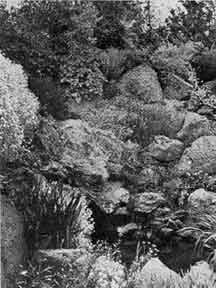Garden Pools, Page 4
By ROMAINE B. WARE
Page 1 | Page 2 | Page 3 | Page 4
Some owners of lily pools are bothered by the formation of a green scum upon the water, usually especially troublesome in hot sunny weather. It is caused by algae, which may be eliminated by dissolving copper sulphate (blue vitriol) in the water. In pools containing no fish this may be used in the proportion of one ounce to about eight thousand gallons of water. The solution should be only one-third as strong when fish are present. Running water is not as likely to be infested by algae.
The growing of vegetation in one's pool is apt to discolor the water. This is perfectly natural and should not be considered objectionable. Some gardeners, however, demand clear sparkling water and this may be maintained through a portion of the pool by building a wall to within about two inches of the water surface and thus separating the area with growing plants in it from the rest of the pool. Such a wall is also desirable in a pool where one attempts to combine growing plants with running water. Most plants like warm water and circulating water not only is inclined to be cool but its motion twists the plants, especially waterlilies, all out of place and it is seldom they grow successfully in moving water. By walling them off this difficulty is obviated.

A ROCK GARDEN SPRING
To plan your garden pool well in advance of the construction is very important. Study your gar den possibilities. Plan informal effects, for they are by far the most interesting; location and grading are also vital. I have in mind as an example of good work a pool built last summer where the owner graded the area by moving soil in a wheelbarrow. In order to secure a natural effect the pool was depressed three feet below the original ground level. On one side the surface was graded back with an easy slope for thirty feet and back of the pool all the soil from the excavation was used to produce a hill about six feet high with its face developed as a rock garden and the summit planted with tall shrubs and evergreens to give height and make a background. The finished effect was perfectly natural and the pool looked as if it "belonged there." This is the kind of effect we should all strive for and it is perfectly possible if we study the problem sufficiently.
Among the plants whose beauty and variety make them ideal for planting about the garden pool are our native ferns. As a class they are adaptable to all degrees of soil and moisture. For the higher parts of the surroundings there are rock ferns, some of which are tolerant of considerable aridity, while other species grow best with much moisture about their roots. One great advantage of ferns is that they live for many years with a minimum of attention. Good gardens don't "just happen." They are the result of carefully worked out plans.
 Printer-friendly version
Printer-friendly version
